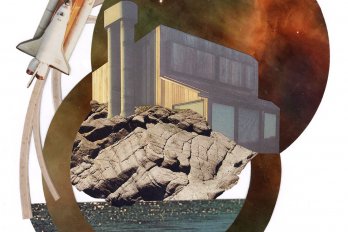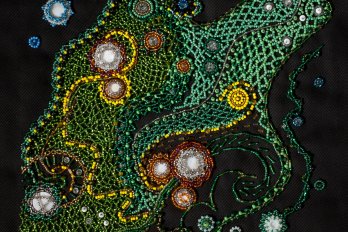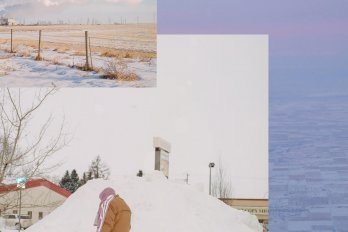Last June, under a spreading maple tree on a hill in the southwest corner of Wisconsin, twenty-five people sat around a bonfire to mourn. To the tempo of a hand drum, they called out recently extinct species, tossing scraps of paper inscribed with animal names into the fire: Caribbean monk seal, Eiao monarch. White ash settled like snowflakes on knees and shoulders. Dusky seaside sparrow. Bulldog rat. Western black rhino.
Ordained ministers and lay leaders, they had come to this hill from across North America, from churches in Texas, Washington, West Virginia, New Hampshire, British Columbia, and Ontario, for the first in-person gathering organized by the Wild Church Network. The network is a loose affiliation of congregations, mostly from different Christian denominations, that belong to the Wild Church movement and meet for worship in the outdoors—surrounded by a New England beech grove, say, or in a forest of cedars along the BC coast, or on the grasslands of Colorado. These worshippers aren’t just seeking picturesque settings: sometimes they gather beside a stream choked with logging debris, or a bleak asphalt parking lot, or the charred skeleton of a burnt-out forest—places where they can face the destruction humans have wrought.
The Wild Church members believe that, somewhere along the way, Christianity lost its communion with the natural world. The late Catholic priest and eco-theologian Thomas Berry wrote in the 1990s about the fissure between Christianity and nature, a split he traced back to the Enlightenment, when rationalists such as René Descartes sought to strip the natural world of its spiritual qualities. Then came the colonial era when European invaders dispossessed Indigenous peoples of their lands and drafted new constitutions that enshrined the rights of the colonizers but gave no rights to the land itself. Colonizers violently converted Indigenous people to Christianity, denouncing as heresy Indigenous beliefs, such as that stones, trees, or rivers could be animated by spirits. “The world around us became a natural resource to be used, not a vital reality to be communed with,” Berry wrote. By taking its quest for the sacred back into the wilderness, the Wild Church movement hopes to heal the damaged relationship between humans, the planet, and God.
If eternity is what matters, why sweat the fate of a finite planet?
“[Climate change] is a saga that used to be understood at the scale of mythology and theology,” observed journalist David Wallace-Wells in a recent interview. Wallace-Wells’s 2019 climate change handbook, The Uninhabitable Earth, reads like a Biblical apocalypse but with sixty-five pages of endnotes. Perhaps, say Wild Church leaders, it’s time for all of us to start thinking on that scale. After all, Christian mythology contains a flood that destroys most of life on Earth as a consequence of human violence. If we saw our ecological crisis as a moral reckoning rather than simply as a technological challenge, we might be more willing to take the necessary action, even if the sacrifices were large and the chances of success small.
Fourteen years ago, Mishka Lysack, an Anglican priest and a professor in the faculty of social work at the University of Calgary, read Australian climate scientist Tim Flannery’s 2005 book The Weather Makers, which foretells the effects of unchecked climate change: drought, desertification, mass species extinction, and escalating human conflict. For two nights in a row, Lysack woke up in a cold sweat.
Then, in 2008, he went to his dean and asked if he could shift his focus from clinical research to climate education. Lysack envisioned a mass movement led by people of faith. They would recognize climate change as an urgent moral issue and forge alliances with scientists, policy makers, and Indigenous peoples. They would shut down coal-burning power plants and push the government to start the kind of sweeping energy transition underway in Germany, which has set an ambitious goal of cutting greenhouse gas emissions to net zero by 2050.
Lysack understood that prioritization of the collective good and a focus on the marginalized were at the heart of many religious movements. In the late eighteenth century, the movement to abolish slavery in Great Britain was led by Christian thinkers, like William Wilberforce, and supported by Quakers and other evangelical churches, which raised funds, printed pamphlets, created artwork, wrote letters to Parliament, and participated in a sugar boycott. This took place during a more religious era, and Christianity had undoubtedly helped create the transatlantic slave trade in the first place, but the religious movement against slavery was still instructive, Lysack felt. He believed that, if the Canadian faithful (Statistics Canada found that 76 percent of Canadians in 2011 still claimed a religious affiliation) united their efforts, they could put a dent in climate change. It would require a campaign with the same “breadth and moral power” as the abolitionist movement, he wrote in a paper. And, like the antislavery movement, it would threaten the economic order. Britain and America had had to envision new economies, ones that did not rely on the cheap labour of enslaved humans; just as difficult could be the transformation of an economy based on oil and the principle of infinite growth. But the timeline would have to be much faster: abolishing slavery had taken generations, and the deadline set by the Intergovernmental Panel on Climate Change for overhauling the fossil fuel–based economy is scarcely more than a decade away.
Lysack spoke in churches, organized climate conferences, and met with bishops, pastors, rabbis, and imams. It was like trying to set fire to damp wood. A few individuals were working feverishly for climate justice, but the masses in the pews seemed willing to make only small-scale changes. Discouraged, Lysack switched his focus to secular audiences: academics and policy makers interested in transitioning to a low-carbon economy. But the question of how to make Christians take action remains.
One hurdle religion may need to clear to seriously address climate change is its preference for the eternal over the temporal. If eternity is what matters, why sweat the fate of a finite planet? A small 2014 study based in the UK found that Protestant Christians and Sunni Muslims who believed in an afterlife and divine intervention were less likely to feel a sense of urgency about the ecological crisis or support technologies such as carbon capture and storage than were secular participants. And, according to a 2015 Pew Research report in the US, white evangelical Christians—many of whom believe that the Earth will eventually be destroyed and true Christians spirited away—were the surveyed demographic least likely to believe the science around climate change. On the other hand, Hispanic Catholics were the surveyed demographic most likely to believe in anthropogenic warming. Religious adherence, broadly speaking, turns out to be less a predictor of attitudes toward climate change than are politics or race. Perhaps a deeper divide lies between believers who subscribe to a theology of dominion—that God gave humans the Earth and its resources for their own gain—and those, like Wild Church members, who see humans in an equal relationship with the rest of creation.
There are signs that churches in Canada are moving slowly but inexorably toward action. In a video released by the Canadian Council of Churches, Citizens for Public Justice, and Kairos around both Easter and Earth Day last year, faith leaders representing twelve different Christian denominations addressed climate change and biodiversity loss, which one speaker called a “spiritual crisis,” and urged the faithful to act. The United Church is the country’s largest Protestant denomination, and it plans to reduce its carbon footprint by 80 percent by 2050 and has voted to divest its holdings from the world’s 200 largest fossil fuel companies. In partnership with an interfaith charity, the church also offers grants of up to $30,000 for congregations to retrofit their buildings with solar or geothermal energy. Lysack believes members of the North American faith community are starting to wake up to the scale of the crisis, but he fears they’ve missed an opportunity to lead and are now running to catch up.
The late religious historian Phyllis Tickle noticed a pattern others have also observed: every 500 years or so, Christianity seems to undergo a major renovation. Half a millennium ago, the Protestant Reformation rattled Roman Catholic Europe, upending the authority of the church and state, triggering wars and persecutions, and introducing the religious and political freedoms that would set the stage for our modern era. Some 500 years before that, Christianity split down the centre, fracturing into divisions that exist to this day: Roman Catholic and Eastern Orthodox. Victoria Loorz, a pastor who convened the Wild Church gathering in Wisconsin, believes Christianity is on the cusp of another seismic shift, this one precipitated by our growing awareness of the catastrophe humans are inflicting on the planet. Either humans will learn a new way of living—one that acknowledges our interdependence with ecosystems and other species—or we’ll vanish. If Christianity survives, Loorz believes, it will be with new language and rituals that nurture relationships with ponds and praying mantises as well as with God.
The North American church may be getting the emergency memo now, but Christians in the global South have been reckoning with climate change for years. Sixteen years ago, a group of Pacific churches, and representatives from elsewhere, met on the drowning islands of Kiribati, issued a statement declaring that climate change was “not an act of God” but caused by human activity, and called on industrialized countries to transition quickly from fossil fuels because “the Pacific people are suffering, crying and dying right now.” It’s no surprise that perhaps the most searing sermon on climate change was delivered by the first pope in modern times to hail from the global South: in his 2015 encyclical, Laudato Sí’: On Care for Our Common Home, Pope Francis called for a “global ecological conversion” and described the Earth as our sister and mother. “We have come to see ourselves as her lords and masters, entitled to plunder her at will. The violence present in our hearts, wounded by sin, is also reflected in the symptoms of sickness evident in the soil, in the water, in the air and in all forms of life,” he wrote. Since then, Laudato Sí’ has received more attention than perhaps any other recent papal encyclical, inspiring many Catholics around the world to make green action plans, divest from fossil fuels, and convene a synod against Amazonian deforestation.
Faith has the power to move people in a way science cannot, says Mardi Tindal, former moderator of the United Church of Canada. “Climate scientists have told me for years that they count on people of faith to speak to the heart because information, knowledge, and reason are not getting us where we need to be.” This is where the Wild Church movement comes in.
Before she established the Wild Church Network, in 2016, Victoria Loorz spent years travelling the US to attend climate rallies with her son, who spoke at these events. Alec Loorz was a teenager when he led a campaign to sue state governments for inaction on climate change. But, after six years of campaigning, both mother and son were burnt out. The young people Victoria had campaigned with had been full of energy at first. Then they’d come face to face with the magnitude of the crisis and had seemed to realize that nothing they ever did would be enough. “Once they recognize the depth of the tragedy, many of them end up depressed and disillusioned,” says Loorz. She watched it happen to her son. “Trying to shift people without understanding and addressing the underlying worldview is like moving a mountain one pebble at a time.” The church was missing an ecological lens, Loorz says, and the environmental movement was missing a spiritual one.
Loorz sees the Wild Church movement nudging the larger church—and society as a whole—toward a different way of being in the world. She’s all for churches getting involved in climate activism or finding ways to lower their carbon footprints, but she believes there’s even deeper work to do: “changing the underlying relationship between humans and the rest of the world.” Wild Church members characterize their faith as a three-way relationship between God, humans, and the natural world. When Wild Church ministers share traditional rituals, like the Eucharist, outside, they often name the plants and animals and ecosystems of their bioregions as members in the pact between humans and the divine. “Our intention is that other churches will adopt it in small ways—shifts in liturgy, shifts in practice,” says Loorz. “We do see this as a reformation.”
Correction March 17, 2020: The article stated that a video in which faith leaders urged action on climate change was released by the United Church of Canada. In fact, the video was released by the Canadian Council of Churches, Citizens for Public Justice, and Kairos.




